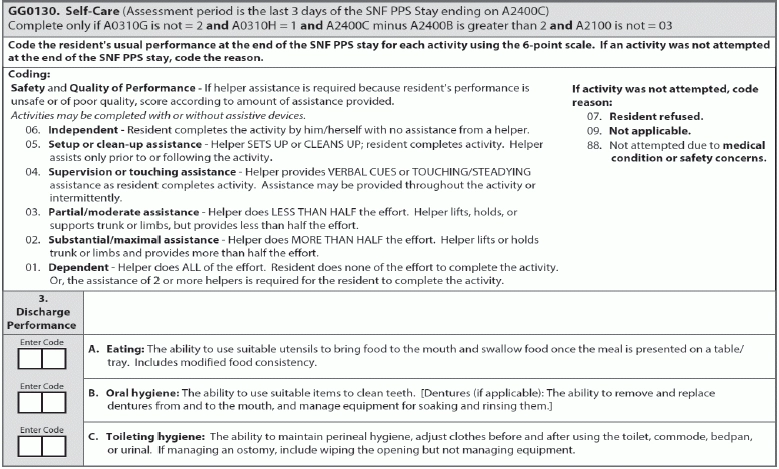Question 1: Staff members don’t walk a resident 50 feet, but instead walk the resident 30 feet due to a medical condition. How do I code GG0170H1?
Answer 1: Item GG0170H1 — Does the resident walk? simply asks whether the resident walks, according to the Kansas Department for aging and Disability services (KDADS).
This item doesn’t have anything to do with walking distance, KDADS explained. The purpose of GG0170H1 is to determine whether to go on to GG0170J — Walk 50 feet with two turns, or whether to skip the walking tasks.
Question 2: What is the ideal number of goals that should be addressed in Section GG?
Answer 2: There is no ideal number of goals to address in Section GG — Functional Abilities and Goals, according to Harmony Healthcare International (HHI). The number of goals should depend on the individual resident. At least one goal is required.
To take a resident-specific approach to setting discharge goals, you should first review the assessment column to verify that the clinical documentation in the medical record supports it, HHI asserted. Then, review the care plan to determine what discharge goals the clinician has established at the time of admission in the therapy care plan or baseline care plan.
Mistake: Don’t try to code goals for every Section GG self-care and mobility item simply to avoid the use of dashes, HHI warned. “In many situations, this would not be appropriate because a goal for a particular item is not established when the patient is currently functioning at the prior level of function and there is no concern that loss of function may occur.”
HHI most often sees this in items GG0130A — Eating and GG0130B — Oral hygiene. If the resident is already independent in these areas at the baseline and the clinician has established no improvement or maintenance goals as part of the care plan, then you shouldn’t code goals in Section GG. Instead, you would code dashes for these items.
Question 3: A resident was admitted to Medicare Part A on Nov. 18, 2016 due to a rectal prolapse repair. The resident refused therapy and was skilled under nursing for one week. The last Part A day was Nov. 29, 2016. He received therapy orders on Dec. 5, 2016, so he would be back on Part A. Is a Start of Therapy (SOT) needed, and do I need to start Section GG?
Answer 3: The resident has been off Part A altogether, so an SOT OMRA would not be appropriate, according to KDADS. The Part A schedule starts all over again with a five-day assessment, which includes Section GG.
Question 4: Many times, I combine the Change of Therapy (COT) with the next scheduled PPS Assessment, but I’ve heard that this reduces our facility’s reimbursement. Can you explain?
Answer 4: Combining the COT with the next scheduled PPS Assessment is a common mistake — in many cases, this is not only unnecessary but also results in reduced reimbursement for six days, says Sally Fecto with HHI. This is specifically true for combining a COT with a scheduled 14-day assessment.
Example: You may choose to complete a standalone scheduled PPS assessment if Day 7 of the COT observation period falls within the Assessment Reference Date (ARD) window of a scheduled PPS assessment, Fecto notes. You can do this by setting the ARD of the scheduled PPS assessment for an allowable day that is on or prior to Day 7 of the COT observation period.
Doing so effectively resets the COT observation period to the seven days following that scheduled PPS assessment ARD.
Question 5: Do we still need to enter hire and termination dates for employees in the Payroll Based Journal (PBJ)?
Answer 5: The Centers for Medicare & Medicaid Services (CMS) recently decided to make the Hire Date and Termination Date fields in the PBJ system optional. You can still enter dates in these fields, but CMS no longer requires you to do so.
Important: If you still want to enter dates in these fields, keep in mind that you should report hire and termination dates at the facility level, not the company level, according to a recently updated FAQ document by CMS. “These dates must reflect the time each staff member worked at an individual facility, and not the dates hired and terminated at a company.”
For contract staff, the hire date is the first date worked and billed for at your facility. If the contractor transfers to a new facility, then the hire date should be the first date that the contractor provided services at the new facility.
The termination date for a contractor is the date the facility or agency communicates that the contracted individual will no longer provide services at that facility (either voluntary or involuntary).
For more information on entering employee data, reference Sections 8.2 and 8.4 of the PBJ User Manual, which you can access at www.qtso.com/pbjtrain.html.

